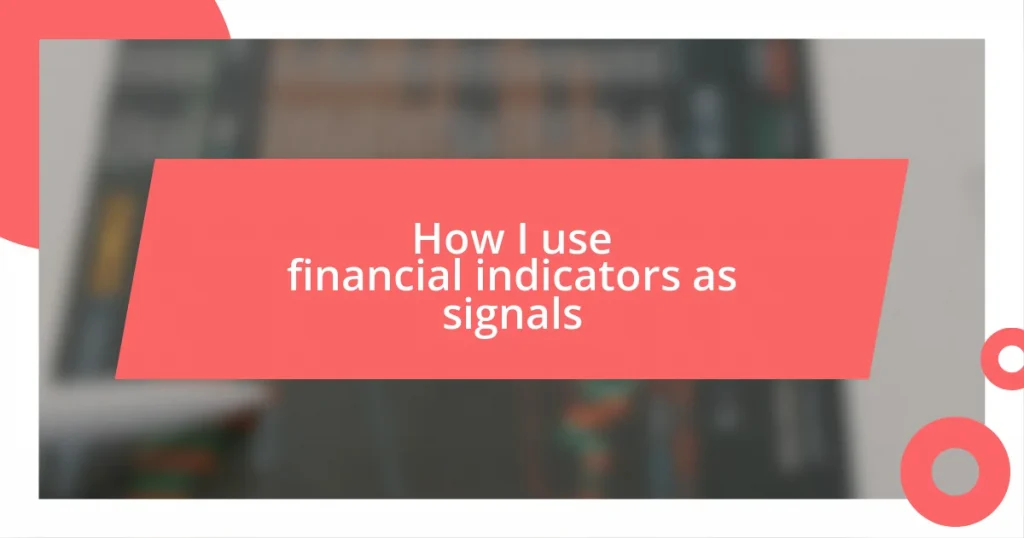Key takeaways:
- Financial indicators like the P/E and Debt-to-Equity ratios are essential for evaluating a company’s profitability and risk, shaping investment strategies and decisions.
- There are three main types of financial indicators—leading, lagging, and coincident—each offering unique insights into market trends and economic conditions.
- Combining multiple indicators, such as moving averages with volume analysis, enhances trading strategies and provides a clearer understanding of market dynamics.
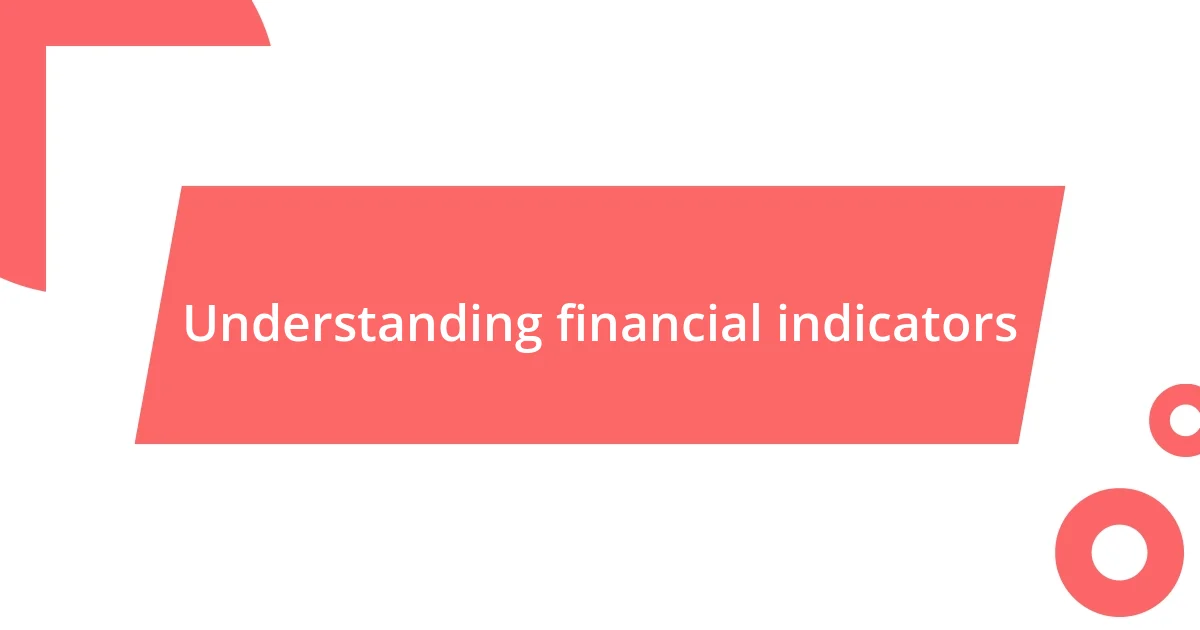
Understanding financial indicators
Financial indicators serve as essential tools for interpreting the health of an investment or the broader economy. I’ve often found myself sitting at my desk, looking at charts and numbers, and wondering how these figures reflect what’s really happening behind the scenes. Did you ever pause to think about how a single number can influence your entire financial strategy?
For example, I remember when I first encountered the Price-to-Earnings (P/E) ratio. At first, it was just a confusing decimal in a sea of financial jargon. However, over time, I realized it’s like a window into a company’s profitability. Every time I analyze a new stock, I can’t help but feel a mix of excitement and nervousness—this indicator gives me insight into whether a stock is truly undervalued or overhyped.
Another indicator that intrigued me is the Debt-to-Equity ratio. It sparked a question: How leveraged is the company compared to its assets? This ratio made me reflect on my own financial decisions, weighing how much risk I was willing to take. I vividly recall a moment of clarity when I realized that a strong balance sheet often leads to more significant opportunities. Understanding these indicators has not only shaped my investment journey but also instilled a sense of empowerment.
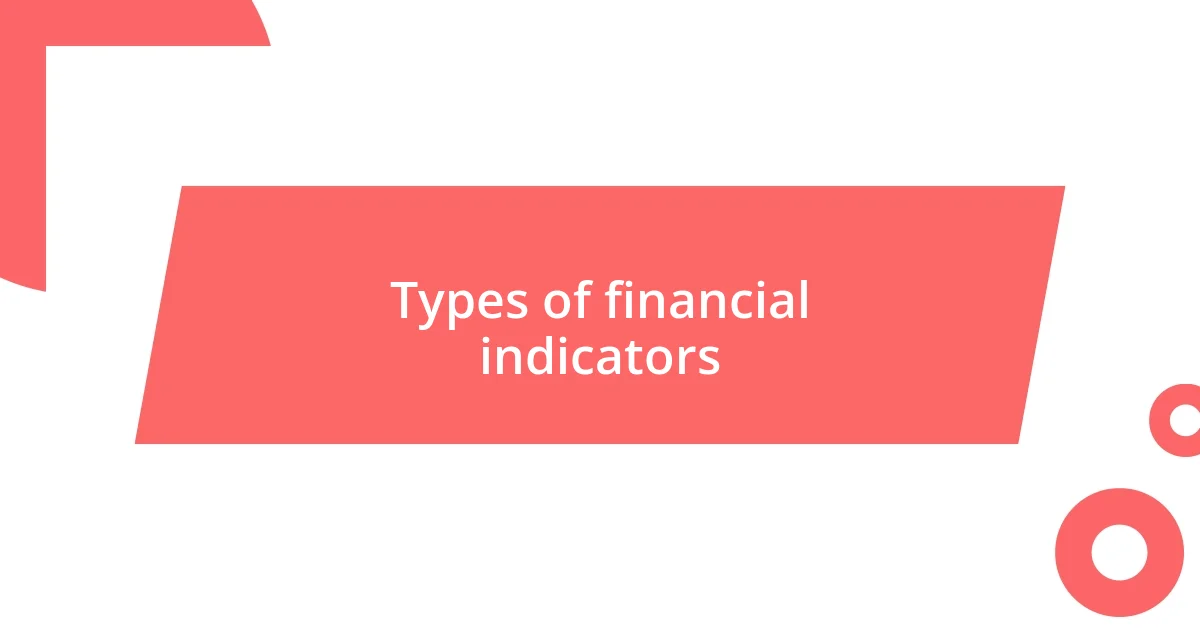
Types of financial indicators
Financial indicators can be broadly categorized into three main types: leading, lagging, and coincident indicators. Each type serves a different purpose in financial analysis. I often think of leading indicators as my early warning system; they give insights into where the market might be headed. For instance, when I follow changes in the manufacturing sector, I keep an eye on new orders, which can signal future economic expansion or contraction.
On the other hand, lagging indicators provide confirmation of trends after they’ve been established. I remember analyzing unemployment rates after a market downturn. Seeing those rates start to decrease gave me a sense of hope and the reassurance that things were turning around, though it was only a reflection of what had already happened. Sometimes, it feels like watching a movie in reverse, where you’re piecing together the story after it has unfolded.
Lastly, coincident indicators move in tandem with the economy, providing real-time data. I find GDP figures particularly illuminating. They make me pause and assess my investment decisions quickly. The interconnectedness of these indicators creates a vivid tapestry of the economic landscape, and I’m always eager to map out how these signals can influence my next move.
| Type of Indicator | Description |
|---|---|
| Leading | Predict future movements in the economy; often act as early signals. |
| Lagging | Confirm trends by reflecting on past data; useful for understanding previous conditions. |
| Coincident | Move in line with economic trends; provide real-time metrics of the economy’s current state. |
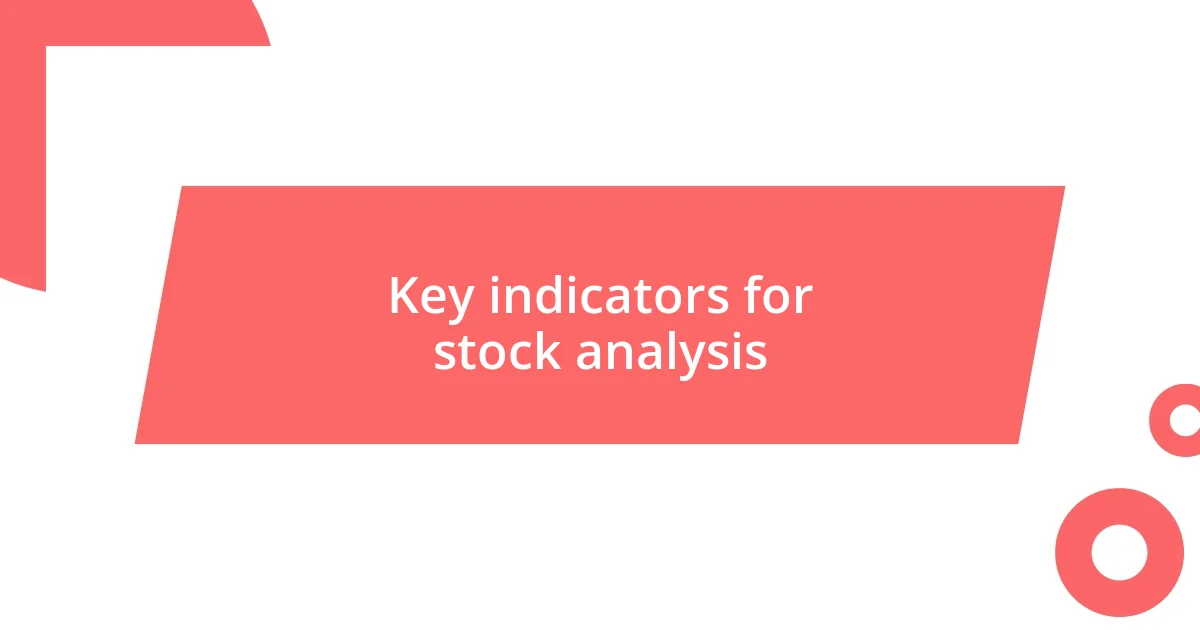
Key indicators for stock analysis
Stock analysis can be quite complex, but certain key indicators make it a bit more manageable. I often find that looking at a company’s earnings growth is vital. When I first started investing, I was captivated by how a consistent rise in earnings could tell me so much about a company’s future. For me, it felt like following a character’s development in a novel; the growth trajectory reveals how well the company adapts to challenges and seizes opportunities.
A few other indicators that I rely on include:
- Price-to-Earnings (P/E) Ratio: Helps me gauge if a stock is over or undervalued.
- Debt-to-Equity Ratio: Offers insights into a company’s financial health and risk level.
- Return on Equity (ROE): Measures how effectively a company generates profits from its equity.
- Current Ratio: Evaluates a company’s ability to pay short-term obligations, which I see as a reflection of liquidity.
- Dividend Yield: Indicates how much a company returns to its shareholders, providing me peace of mind during volatile markets.
Every time I see a high ROE, I remember the thrill of uncovering a hidden gem on my journey. Those moments ignite a sense of excitement, as if I’ve cracked a code that others may overlook. It’s these indicators that guide my decisions, reminding me of the dynamic nature of the investment world.
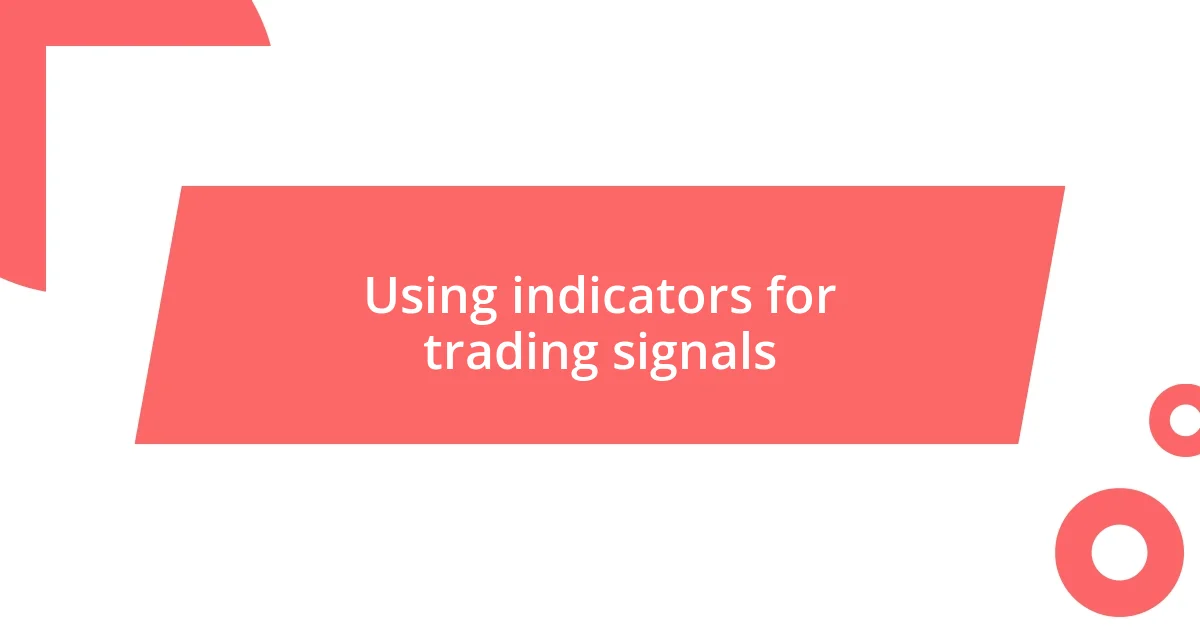
Using indicators for trading signals
Using financial indicators as trading signals has greatly influenced my decision-making process. One approach I often take is to look at moving averages. I remember my first encounter with the simple moving average (SMA); it felt like unlocking a secret pattern in the stock’s price movements. By observing where the stock price intersects the SMA, I can determine potential buy or sell points. It’s amazing how a straightforward calculation can reveal such profound insights!
Another indicator I find immensely valuable is the Relative Strength Index (RSI). I once narrowly escaped a potential loss when I noticed an extreme RSI reading. At the time, the market was buzzing, but that indicator whispered to me that the stock was overbought. It made me pause and reassess my strategy, proving how crucial it is not to get swept up in market emotions.
Lastly, volume is something I can’t ignore. I distinctly recall a day when I was tempted to jump into a position based on positive news. However, a quick glance at the trading volume indicated a lack of real interest behind the price movement. This experience taught me that strong trading volume can signal conviction in a price move, helping me make informed choices amidst the noise of the market. Don’t you think these indicators can ultimately shape our understanding of market dynamics? I certainly believe they can!
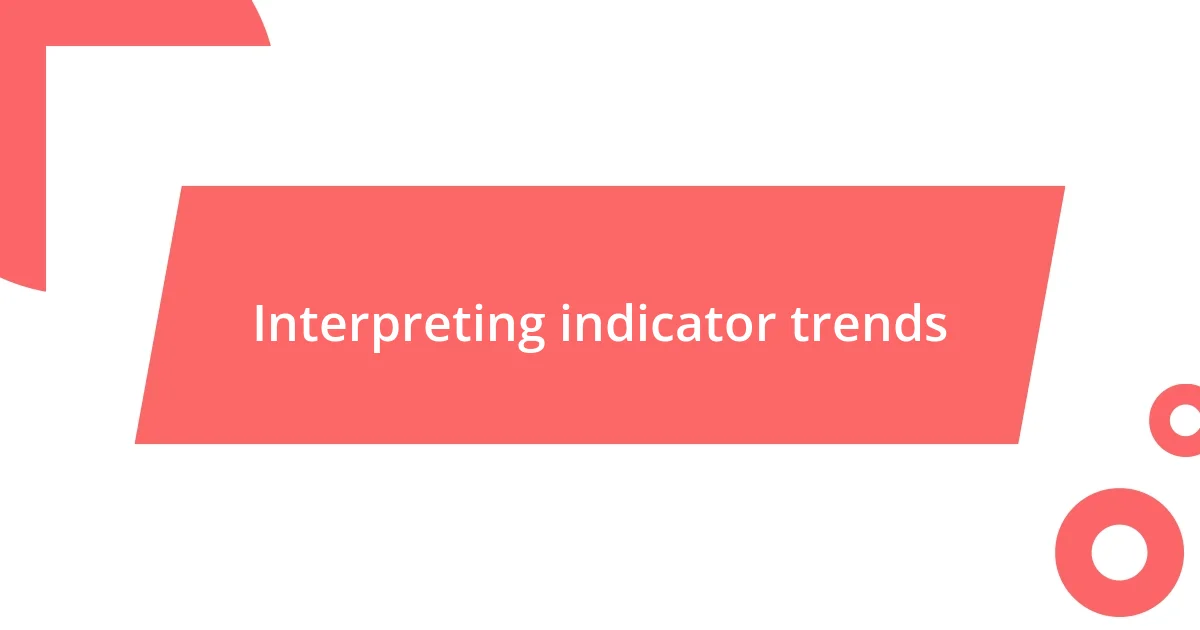
Interpreting indicator trends
Interpreting indicator trends requires a keen eye and a willingness to look beyond the surface. I vividly remember my excitement the first time I noticed a stock’s price gradually rising while the P/E ratio remained stable. It felt like piecing together a mystery—was the market finally catching on to the company’s potential? This balance often indicates a healthy growth trajectory that I eagerly look for in my analyses.
Another experience that stands out to me is when I closely monitored the current ratio during a market downturn. I was invested in a company, and when I saw its current ratio steadily improving while others faltered, I felt a rush of confidence. It was exhilarating to understand that this indicator signaled resilience. It made me ponder: how often do investors overlook what could be the telltale signs of stability in turbulent times?
Lastly, I often reflect on the importance of analyzing trends over time rather than fixating on a single data point. There was a moment when I noticed a steady increase in dividend yield; it wasn’t just a spike, but a trend. That pattern not only reassured me of the company’s commitment to returning value to shareholders but also inspired trust in its management. Have you ever noticed how historical trends can provide deeper insights into a stock’s true potential? For me, it’s these nuances that make investing feel like an artful dance between numbers and narratives.
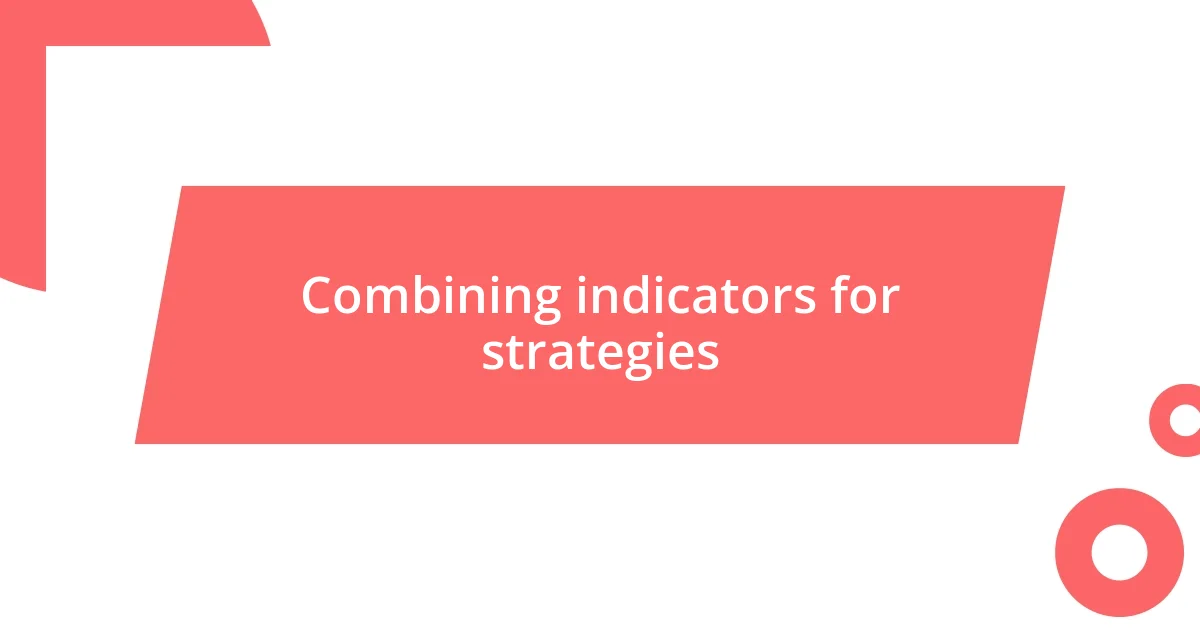
Combining indicators for strategies
Combining indicators can amplify your trading strategies in ways that are often underestimated. For instance, I’ve found that when I align the signals from both moving averages and the RSI, it can create a powerful narrative. I recall a particular moment when both indicators signaled a bullish trend—a sweet combination that prompted me to go long. It was as if the market was providing a clear green light, reassuring me that I was making a sound decision.
Moreover, I enjoy blending volume analysis with trend indicators. There was a time when I hesitated before making a significant investment because the volume was inconsistent despite positive news. By integrating this with a moving average convergence divergence (MACD) signal, I could better gauge whether the hype was legitimate or just noise. It really drove home the point that volume can either validate or undermine trends, shaping my strategy in a more nuanced way.
Engaging multiple indicators also keeps me focused on a broader market narrative. I remember trying out a combined approach using Bollinger Bands and the Stochastic Oscillator. When I noticed the price touching the lower band while the oscillator suggested it was oversold, I took that as a cue to explore entry points. It has me wondering—how often do we overlook the potential synergy of our indicators? By weaving them together, I’ve experienced how combining insights can enhance my understanding and ultimately lead to more informed trading decisions.
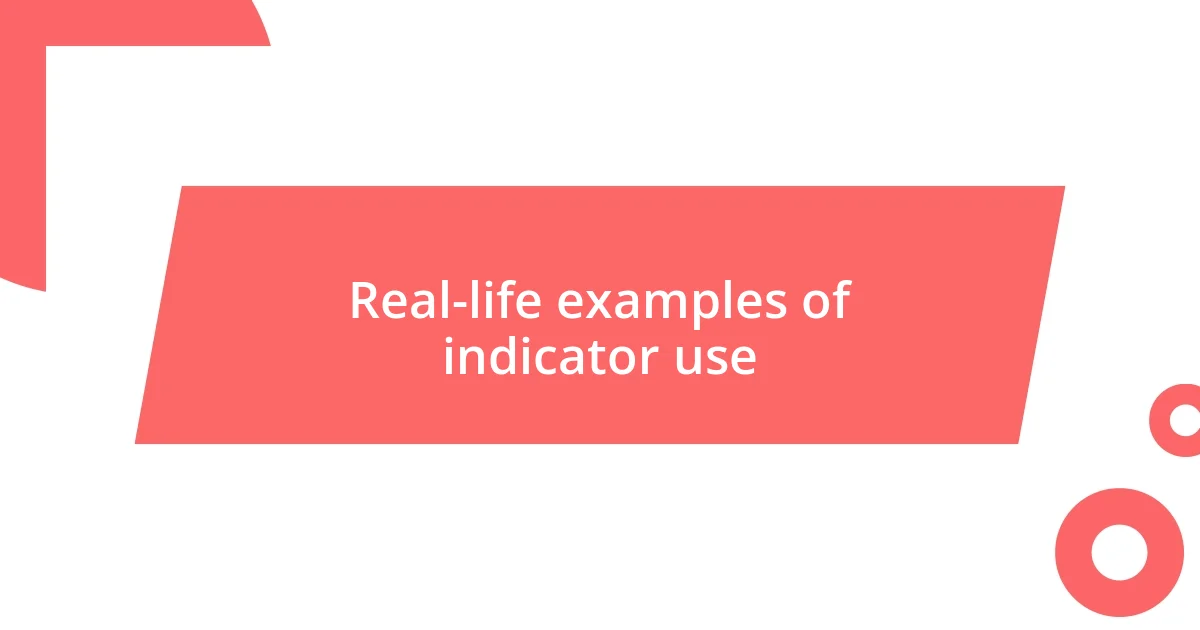
Real-life examples of indicator use
I remember a time when I was diving into the intricacies of the moving average convergence divergence (MACD) indicator. I had been following a particular stock, and suddenly, the MACD line crossed above the signal line. My heart raced; this crossover often signals a potential bullish momentum. My instinct told me to act quickly, and I did. It turned out to be a rewarding decision, demonstrating just how vital timely responses to such indicators can be. Isn’t it fascinating how one simple line crossover can shape your entire investment approach?
Another instance that stands out was when I tracked the price-to-book (P/B) ratio of a tech company amid an industry boom. As I watched the P/B ratio decline while the stock price surged, I felt a mix of concern and curiosity. Could the market be overvaluing this company? My research revealed historical trends indicating the company’s growth potential was still strong. This experience highlighted how critical it is to question apparent trends. Have you ever paused to reflect on the deeper implications behind numbers? It’s moments like these that enrich our understanding of the market.
Lastly, I vividly recall using the Fibonacci retracement levels in a recent analysis. As I drew the lines on the chart, I noticed the stock price bouncing off the 61.8% retracement level. It was as though the chart was practically shouting at me—a natural support level! I felt an electric mix of excitement and caution as I prepared to enter a position. This experience reinforced the idea that market behavior often reflects human psychology. Isn’t it intriguing how investor sentiments can create predictable patterns in stock prices? Engaging with these indicators allows us to tap into the collective mindset of market participants, and I find that exhilarating.










